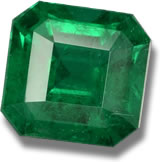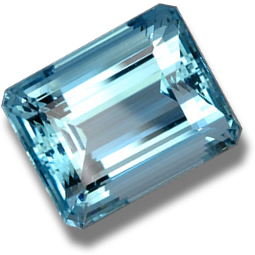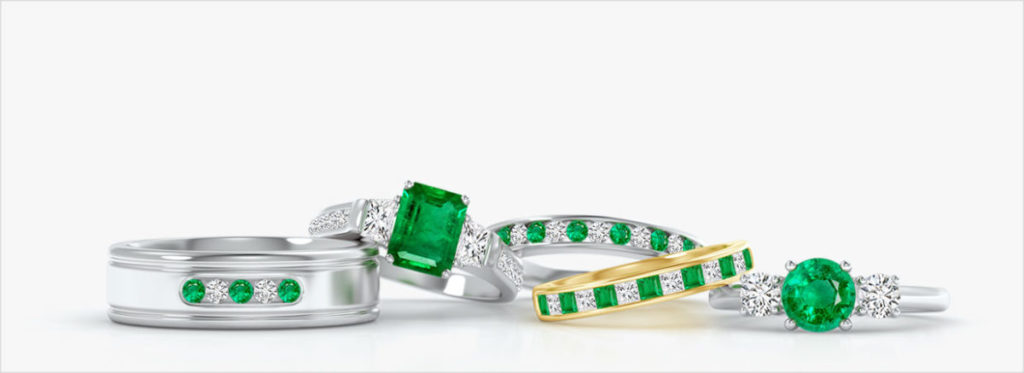About Emerald – History and Introduction

Emerald is the most precious stone in the beryl group. The name comes from the old French word ‘esmeralde’, which was derived from the Greek word ‘smaragdos’ meaning ‘green stone’. By definition, emerald is any medium to dark green beryl colored by chromium. Green beryl colored only by vanadium is not considered to be true emerald, but rather as simply green beryl. Since the 1960s, the American jewelry industry changed the definition to include vanadium colored beryl as ’emerald’, but in the UK and Europe, they are still not recognized as such. The historical green color of emerald is unparalleled in the world of gemstones and it is considered as one of the most ‘precious four‘ of all gemstones, which also includes sapphire, ruby and diamond. Although emeralds are one of the most valuable gemstones available today, most are very heavily included, rendering their resistance to breakage as generally poor. According to GIA, emerald is a Type III clarity gemstone, which means that even good quality emerald used in fine jewelry today is in the I2 to I3 range.
Although Colombia is the most famous source for ‘deep green’ emeralds, emerald deposits are mined from many locations around the world. Recent decades have seen emerald production increase as a result of newly discovered deposits in South America, Africa and across Europe. Today, Brazil and Zambia are among the leading producers of fine emeralds, following Colombia. Brazilian emeralds are prized for their excellent clarity and slightly yellowish green color, while Zambian emeralds are desired for their slightly bluish green color, which is similar to that of Colombia’s ’emerald-green’ emeralds.
Identifying Emerald
Almost all natural emeralds contain distinct characteristic inclusions and almost all are treated with oil or resin to fill tiny fissures and cracks. It is the presence of these flaws and oil which makes it quite easy to identify and distinguish natural emeralds amongst other similar gemstones. Artificial light will expose and amplify inclusions and fractures that prove the stone to be a natural emerald. Emerald color is owed to trace amounts of chromium and vanadium, and color is best admired under natural daylight. One of the easiest methods to identify green emeralds is to test for specific gravity (density) and hardness. Like all forms of beryl, emerald is harder than apatite, quartz and feldspar, but is slightly softer than spinel, topaz and sapphire. However, emerald is generally more fragile than other beryl, owing to its naturally included state.
Emerald Origin and Gemstone Sources
Emerald mining is almost exclusively done from host rocks, where the emerald has grown into small veins or on walls of cavities.
Colombia is the international center of emerald mining. The Muzo Mine, northwest of Bogotá, produces fine-quality stones of a deep green color. The Chivor Mine, northeast of Bogotá, is another important deposit, and other locations promise additional successful mining results.
Brazil has various deposits in Bahia, Goias and Minas Gerais. The stones are lighter than the Colombian ones; mostly yellow-green and are often free of inclusions. Brazil also supplies rare emerald cat’s eyes and extremely rare emeralds with a six-ray star.
South African deposits are concentrated in the Northern Transvaal. But only five percent of the stones found in the Cobra and Somerset Mines are of good quality. Most stones are light or muddy and are only suitable for cabochon cuts.
Zimbabwe has several deposits of emerald; the most important is the Sandawana Mine in the south. The crystals are small, but of very good quality.
Russia has deposits in the Ural, north of Sverdlovsk. Good quality emeralds are rare; most stones are light or muddy and only suitable for cabochons.
Further deposits are in Afghanistan, Australia (New South Wales and Western Australia), Ghana, India, Madagascar, Malawi, Mozambique, Namibia, Nigeria, Pakistan, Tanzania, Zambia and the United States (North Carolina).
Buying Emeralds and Determining Emerald Value
Emerald Color
With emeralds, even more so than other colored gems, it is the color that is the chief determinant of value. By definition, emeralds are a medium to darker green to blue-green and sometimes slightly yellowish-green beryl. Emeralds owe their fine green color to traces of chromium and/or vanadium impurities. The most popular and valuable color is a slightly bluish green in a medium dark tone with strong to vivid saturation, however, too much blue can decrease the value.
The term “Colombian emeralds” is often used to describe vivid, slightly bluish-green stones of a medium to medium dark color, regardless of their geographic origin. Emeralds of a lighter color are sometimes called “Brazilian emeralds”, even if they were mined in Africa.
Emerald Clarity and Luster
Emeralds have a vitreous (glass-like) luster when cut and polished. Although their clarity can occur from translucent to opaque, transparent specimens are most desirable and are much more valuable. Clarity is important, but inclusions are tolerated more in emeralds than virtually any other gem. Unlike other beryl gems, emeralds often contain inclusions and other flaws. These flaws are not looked upon as negative attributes for emeralds, as they would be for other gemstones. Indeed, these flaws are considered part of the character of the stone and are used to assure the purchaser of a natural stone.
Emerald clarity is graded by eye, unlike diamond, where 10x loupe magnification is used to grade clarity. If an emerald has no inclusions that are visible to the naked eye, it is considered flawless. “Eye-clean” stones will command the highest prices, especially those with ideal color grade.
Emerald Cut and Shape
Emeralds are most often cut in a special cut designed just for this gem; “the emerald-cut“. The emerald cut is a step-cut or trap-cut featuring a rectangular or square shape with truncated corners. This cutting style maximizes the beauty and color of the stone, whilst protecting it from mechanical strain and internal stress. Emeralds are also cut into a variety of other traditional shapes such as pear, oval and round. Lower grade materials are often cut en cabochon or into beads. Highly transparent and clear materials are sometimes cut in brilliant-style.
Emerald Treatment
Oiling is a common emerald treatment and in most cases, it is done right at the mining location. The term ‘oiling’ refers to the practice of immersing emeralds in a colorless oil or resin (most often cedar oil) in order to enhance color, clarity and stability. This is also often done using a vacuum chamber to assist penetration. Non-standard treatments go beyond this by using colored oils and epoxy-like resins.
These treatments dramatically improve the appearance of the gems, but necessitate special care in cleaning and setting. Steam cleaners, solvents and ultrasonic cleaners can remove the oils, making inclusions that were barely visible stand out in sharp relief. Since emeralds can be restored through re-oiling, the damage is considered to be only temporary.
Synthetic emeralds have been available since 1848. In the 1950s, synthesizing methods became commercialized and excellent quality synthetics have been made available since. The term ‘Chatham emeralds‘ is often used for lab-grown emeralds. There are also numerous emerald doublets available. In many cases, a natural upper-half is cemented to a glass or synthetic pavilion using an emerald-green paste. With the visibility of emerald flaws from the crown down, once these are set into jewelry, they are often sold as natural emeralds.
| Species: | Emerald – beryl |
| Chemical Formula: | Al2Be3Si6O18 – Aluminum beryllium silicate |
| Crystal Structure: | Hexagonal; hexagonal prisms |
| Color: | Emerald green to green to slightly bluish or yellowish-green |
| Hardness: | 7.5 to 8 on the Mohs scale |
| Refractive Index: | 1.565 to 1.602 |
| Density: | 2.67 to 2.78 |
| Cleavage: | Indistinct |
| Transparency: | Transparent to opaque |
| Double Refraction or Birefringence: | -0.006 |
| Luster: | Vitreous |
| Fluorescence: | Usually none |
Emerald: Related or Similar Gemstones:

Emerald belongs to the important group of beryl gemstones. There are quite a few different gemstone-quality varieties of beryl, most of which are classified based on color and coloring agents, such as pink morganite and red bixbite. There are also many other green colored gemstones that can be confused with green emerald, including green aventurine quartz, demantoid garnet, tsavorite, chrome tourmaline, chrome diopside, grossularite garnet, uvarovite garnet, verdelite, fluorite, hiddenite and peridot.
Most Popular Related Gemstones:
Aquamarine, golden beryl, precious beryl and green beryl are the most popular and well-known related gemstones.
Lesser-Known Related Gemstones:
Goshenite, morganite, heliodor, bixbite and ‘trapiche emerald’ are lesser-known related gemstones.
Emerald Mythology, Metaphysical and Crystal Healing Properties
Innumerable fantastic stories have grown up around this magnificent gem. The Incas and Aztecs of South America, where the best emeralds are still found today, regarded the emerald as a holy gemstone. However, probably the oldest known finds were made near the Red Sea in Egypt. These gemstone mines, exploited by Egyptian pharaohs between 3000 and 1500 B.C. and later referred to as “Cleopatra’s Mines”, had already been exhausted by the time they were rediscovered in the early 19th century.
Written many centuries ago, the Vedas, the holy scriptures of the Hindus, say the following of the precious green gems and their healing properties: ‘Emeralds promise good luck’ and ‘the emerald enhances the well-being’. No wonder the treasure chests of Indian maharajas and maharanis contained wonderful emeralds. Emerald is the official birthstone for May and the official anniversary gemstone for commemorating the 20th and 35th year of marriage.
World-famous Emeralds
One of the world’s largest emeralds is the so-called ‘Mogul Emerald’. It dates from 1695, weighs 217.80 carats, and is some 10cm tall. One side of it is inscribed with prayer texts, and there are magnificent floral engravings on the other side. This legendary emerald was auctioned by Christie’s of London to an unidentified buyer for 2.2 million dollars on September 28th, 2001.
Emeralds have been held in high esteem since ancient times. For that reason, some of the most famous emeralds are to be seen in museums and private collections.
The New York Museum of Natural History, for example, exhibits a cup made of pure emerald, which belonged to the Emperor Jehangir, next to the ‘Patricia’, one of the largest Colombian emerald crystals, which weighs 632 carats.
The collection of the Bank of Bogotá includes five valuable emerald crystals with weights of between 220 and 1796 carats.
Splendid emeralds form part of the Iranian National Jewelry Treasury, adorning, amongst other things, the majestic diadem of the former Empress Farah.
The Turkish sultans also loved emeralds. In Istanbul’s Topkapi Palace there are exhibits of items of jewelry, writing implements and daggers, each lavishly adorned with emeralds and other gems.
The Viennese treasury contains a vase, 4.5 inches (12 cm) high, with a weight of 2205 carats, which was cut from a single emerald crystal.
Her Majesty, Queen Elizabeth II, has so much jewelry that she has a special room to keep it in, said to be about the size of an ice rink, and situated 40 feet beneath Buckingham Palace. This does not even include the British Crown Jewels, which are kept in the Tower of London. The Queen’s personal jewelry is conservatively valued at $57 million and most of it was received as gifts. The fabulous gems in her collection include the “Cambridge and Delhi Dunbar Parure”, a fantastic suite of emerald jewelry which includes an emerald diadem.
Elizabeth Taylor also had a well-known jewelry collection. As an engagement present, Richard Burton gave her an emerald and diamond brooch, which she wore with an emerald necklace he gave her as a wedding present. Earrings, a bracelet, and a ring followed.
| Disclaimer: Metaphysical and Alternative Crystal Healing Powers and Properties are not to be taken as confirmed advice. Traditional, Ceremonial and Mythological Gemstone Lore is collected from various resources and does not represent the sole opinion of SETT Co., Ltd. This information is not to replace the advice of your doctor. Should you have any medical conditions, please see a licensed medical practitioner. GemSelect does not guarantee any claims or statements of healing or astrological birthstone powers and cannot be held liable under any circumstances. |
Emerald Gemstone and Jewelry Design Ideas
Green emeralds are excellent gemstones for most types of gemstone jewelry. They are considered to be fairly hard, although not so tough owing to the natural flaws of emeralds. They also have a good level of fire and brilliance which makes them ideal gemstones for open settings. Green emeralds are perfect for setting in large gemstone emerald rings and pendants. They are best set into designs that allow light to pass through easily in order to maximize transparency. The truncated corners of the ’emerald’-cut’ were designed to help emeralds to be more ‘wearable’ as they reduce the risk of facet corners breaking and chipping. When wearing emeralds, emerald cuts, ovals and other shapes without pointed facet corners are the safest.
Emeralds are excellent gems for beaded and tumbled jewelry, such as strands and bracelets, but typically only lower grade emeralds are reserved for this type of jewelry use. Emeralds in general are one of the most popular gemstones in the world and they are a favorite among the elite, especially considering that they are one of the ‘precious four’ gems. Unlike many other rarer colored stones, emeralds are often available in local jewelry stores, usually as high-end designs. All emeralds are brittle, and due to their internal stress, extra care should be taken during setting, cutting and repolishing. Emeralds are sensitive to heat and pressure, so jewelers should be careful when setting them.
Note: Buy colored gemstones by size and not by carat weight. Colored stones vary in size-to-weight ratio. Some stones are larger and others are smaller than diamond by weight in comparison.
Emerald Gemstone and Jewelry Care and Cleaning
 Precious emerald is sensitive to pressure and vulnerable to household chemicals. Although emerald is one of the harder gemstones, it does still require careful handling, due to its naturally included and flawed formation. Extra care should be taken when handling emeralds as they are more fragile than other forms of beryl. Avoid wearing emerald jewelry when working with harsh chemicals or household cleaners, such as bleach or acid. When cleaning, you can use warm soapy water and a tissue or a soft cloth. Be sure to rinse the stones well to remove all soapy residue.
Precious emerald is sensitive to pressure and vulnerable to household chemicals. Although emerald is one of the harder gemstones, it does still require careful handling, due to its naturally included and flawed formation. Extra care should be taken when handling emeralds as they are more fragile than other forms of beryl. Avoid wearing emerald jewelry when working with harsh chemicals or household cleaners, such as bleach or acid. When cleaning, you can use warm soapy water and a tissue or a soft cloth. Be sure to rinse the stones well to remove all soapy residue.
Avoid ultrasonic cleaners and steamers when cleaning your emeralds as these can remove the oils that are used to enhance the emeralds. Traditional oiling for emeralds is stable but not permanent, which means that most emeralds will need re-oiling every so often to return some of their lost color and luster. Always remove any emerald jewelry before exercising, cleaning, playing sports or engaging in vigorous physical activities. Emeralds can easily scratch other gems, and they can easily be scratched by harder gems such as topaz and sapphires. To prevent scratches, store emeralds away from other gemstones and gemstone jewelry. Store your gemstones by wrapping them in soft cloth and placing them in a fabric-lined box.
Source: https://www.gemselect.com/gem-info/emerald/emerald-info.php

